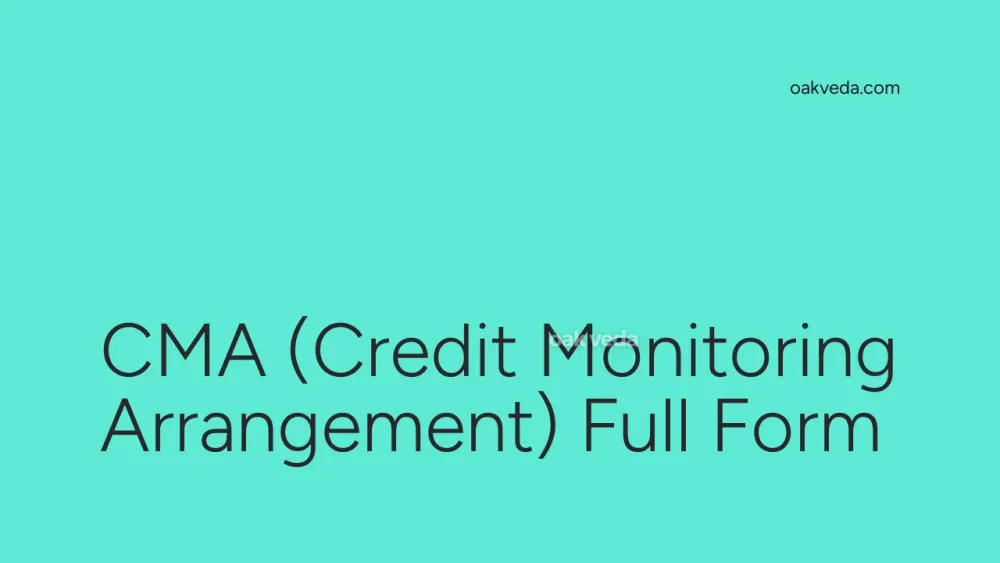
What is the Full Form of CMA?
The full form of CMA is Credit Monitoring Arrangement. This term is widely used in the banking and financial sectors, particularly in relation to business loans and credit analysis. It's important to note that CMA can also stand for Certified Management Accountant, which is a professional certification in management accounting. However, for this article, we'll focus on the Credit Monitoring Arrangement aspect.
What is Credit Monitoring Arrangement?
Credit Monitoring Arrangement is a comprehensive financial report that provides an in-depth analysis of a company's past performance and future projections. This report is crucial for banks and financial institutions when evaluating loan applications from businesses. The CMA report offers a detailed view of a company's creditworthiness and its ability to repay loans.
Origin and Development of Credit Monitoring Arrangement
The concept of Credit Monitoring Arrangement evolved as financial institutions sought more effective ways to assess the risk associated with lending to businesses. As the complexity of business operations increased, traditional methods of credit assessment became insufficient. CMA was developed to provide a more holistic and forward-looking approach to credit analysis.
How does Credit Monitoring Arrangement work?
The CMA process involves a thorough examination of various financial aspects of a company:
- Historical financial performance
- Current financial position
- Future financial projections
- Industry trends and market conditions
- Management quality and business strategy
Banks and credit analysts use this information to create a comprehensive CMA report, which forms the basis for loan approval decisions.
Functions of Credit Monitoring Arrangement
The primary functions of CMA include:
- Risk Assessment: Evaluating the potential risks associated with lending to a particular business.
- Creditworthiness Determination: Assessing a company's ability to repay loans based on its financial health.
- Loan Structuring: Helping banks determine appropriate loan terms and conditions.
- Ongoing Monitoring: Providing a framework for continuous assessment of a borrower's financial performance.
Applications of Credit Monitoring Arrangement
CMA is applied in various scenarios:
- New Loan Applications: When businesses apply for new loans or credit facilities.
- Loan Renewals: For reassessing existing loans and deciding on renewals.
- Credit Limit Adjustments: When companies request increases in their credit limits.
- Restructuring of Loans: In cases where businesses face financial difficulties and need to renegotiate loan terms.
Features of Credit Monitoring Arrangement
Key features of a CMA report include:
- Comprehensive Financial Analysis: Detailed examination of balance sheets, income statements, and cash flow statements.
- Industry Benchmarking: Comparison of the company's performance with industry standards.
- Ratio Analysis: Calculation and interpretation of key financial ratios.
- Projections Review: Analysis of the company's future financial projections and their feasibility.
- Working Capital Assessment: Evaluation of the company's short-term liquidity and operational efficiency.
Benefits of Credit Monitoring Arrangement
CMA offers several benefits:
- Informed Decision Making: Provides banks with a solid foundation for loan approval decisions.
- Risk Mitigation: Helps identify potential risks early, allowing for proactive measures.
- Customized Lending: Enables banks to tailor loan terms to a company's specific financial situation.
- Improved Monitoring: Facilitates ongoing assessment of borrowers' financial health.
- Enhanced Communication: Promotes transparent communication between lenders and borrowers.
Limitations or Challenges of Credit Monitoring Arrangement
Despite its benefits, CMA has some limitations:
- Time-Consuming: Preparing and analyzing a CMA report can be a lengthy process.
- Reliance on Projections: Future projections may not always accurately reflect actual performance.
- Complexity: The depth of analysis required can be challenging for smaller businesses or startups.
- Potential for Bias: Analysts' subjective judgments can influence the interpretation of data.
Future Developments in Credit Monitoring Arrangement Technology
The future of CMA is likely to be shaped by technological advancements:
- AI and Machine Learning: These technologies could automate much of the data analysis process, making it faster and more accurate.
- Real-Time Monitoring: Advanced systems may allow for continuous, real-time monitoring of borrowers' financial health.
- Integration with Big Data: Incorporating broader market and economic data could provide more context to financial analyses.
- Blockchain Technology: This could enhance the security and transparency of financial data used in CMA reports.
FAQs on CMA Full Form
-
What does CMA stand for in banking? In banking, CMA stands for Credit Monitoring Arrangement.
-
Is CMA report mandatory for all loan applications? While not universally mandatory, many banks require a CMA report for significant business loan applications.
-
How often is a CMA report prepared? CMA reports are typically prepared annually or when a company applies for a new loan or credit facility.
-
Can small businesses benefit from CMA? Yes, while more common for larger loans, CMA can help small businesses understand their financial position and improve their chances of loan approval.
-
Who prepares the CMA report? CMA reports are usually prepared by credit analysts at banks or specialized financial institutions.
In conclusion, Credit Monitoring Arrangement plays a crucial role in the lending process, providing a comprehensive framework for assessing and monitoring business loans. As financial landscapes evolve, CMA continues to be an essential tool for both lenders and borrowers in managing credit risks and opportunities.
You may be interested in:

